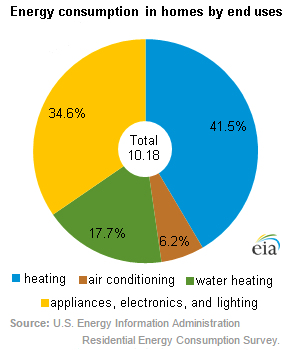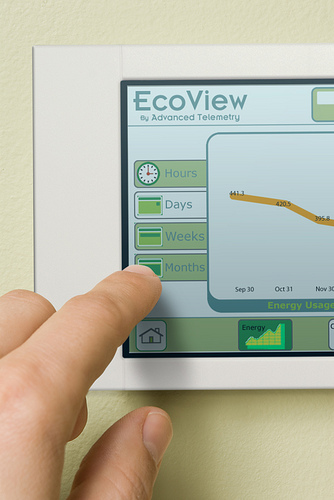
Next to your mortgage, energy costs are one of your major monthly expenses.
The average U.S. household spends about $325 on heating and cooling a month, and that’s not even half of your total energy bill… you also have water heating and appliances, electronics and lighting.
Of course energy usage varies drastically by location, size of home and individual lifestyle.
It is understandable that families want to cut some of these costs, especially when money is tight. The following are just a few tips to help your family reduce their household bills.
Energy-Efficient Appliances
According to the U.S. Energy Information Administration (EIA) almost 35% or your energy bill goes toward powering your appliances, electronics and lighting. The simplest way to reduce energy consumption is to replace some appliances in the house with their energy-efficient counterparts, however, that costs money. Of course if you have to replace something anyway, that is a good time to look for the most energy efficient model you can find. There are a number of energy-efficient appliances homeowners can buy, such as washing machines or microwaves. This can end up reducing the amount of energy used throughout the day. However, to be truly frugal you need to be conscious of everything that is using electricity and turn them off when not in use. Unfortunately, even though many appliances are becoming more energy efficient many are actually using more electricity and doing it in sneaky ways.
Track Down Energy Thieves
Today more and more devices are running on DC current including TV’s, Laptops, and most electronics. The problem with DC devices is that the electricity that comes from the wall outlet is AC and so before it can be used it must be converted to DC. In most cases this is done by a little black box that is either plugged into the wall directly or is in the cord somewhere. The problem is that this box is almost always on converting AC to DC and using electricity to do it, even if you turn the device itself off. And killing power to the “black box” is generally inconvenient so most people don’t do it. One way to cut out these energy thieves is to plug them all into one “surge strip” and then use the switch on the strip to kill the power to all of them at once.
Temperature Woes
The biggest household energy user is heating and cooling. According to the EIA, in the average home in the U.S., 41.5% of energy usage goes toward heating and another 6.2% goes toward cooling. However, if you live in a hot climate like Florida, Alabama, Texas or New Mexico the reverse would probably be the case. There are a variety of ways to reduce heating and cooling costs but fortunately the same methods work for both . Edge Guys HVAC, recommend having a professional energy audit to identify energy leaks, sealing leaky ducts, buying high efficiency HVAC units, using programmable thermostats to reduce energy consumption when you are not home, and installing zone heating, which allows you to only condition the areas of your home that you are currently using. They also recommend , hybrid fuel systems to take advantage of the cheapest fuel and variable speed systems to help them run more efficiently.
In addition, be sure to change your filters regularly because if you don’t you are forcing the HVAC system to work harder to keep a home at an acceptable temperature and reducing the life of the unit. One thing most people don’t know is that dry air feels colder than moist air and most heating systems dry out the air. So in the winter, adding moisture to the air through a humidifier will actually help your house feel warmer and as a bonus it will actually make it healthier, since dry air dries your sinuses and can make you more susceptible to catching a cold.
Reduce Hot Water Usage
It may seem inconsequential, but the truth is that using hot water to clean clothes can increase your energy bill. Remember, according to the EIA 17.7% of your energy usage goes to produce hot water. Every time you turn on the hot water faucet an equal amount of cold water enters your water heater and has to be heated again, then the hot water has to push all the cold water out of the pipe until it reaches your faucet. In cold weather it may have to warm up the pipe as well. In addition, your water heater has to keep the water hot even if you don’t use any (although this takes less energy than heating cold water). So don’t turn on the hot water when you don’t need to. Take shorter showers and use water saving shower-heads. Instantaneous water heaters eliminate the need to keep the water hot and can be placed closer to the point of use thus reducing pipe heat loss waste.
Use less hot water for laundry. Keep in mind that an average household does two to three loads per week. The best thing that you can do is make sure that each load is washed in cold water instead of hot (your clothes will probably get just as clean). If cold won’t do, try warm instead of hot… and always rinse with cold water.
It is also a good idea to wash intimates by hand, they will last longer and use a lot less energy. In nice weather, drying clothes on a clothesline uses much less electricity than a clothes dryer and your clothes come out smelling much fresher as well.
You Might Also Like:


